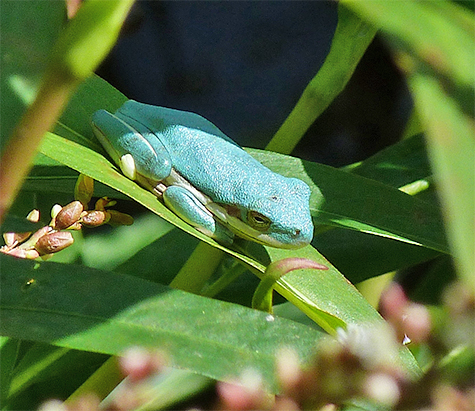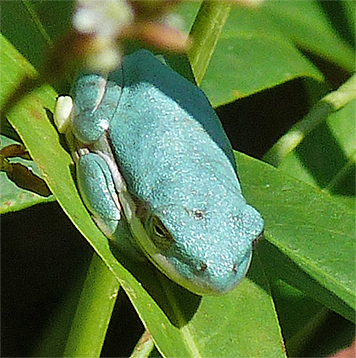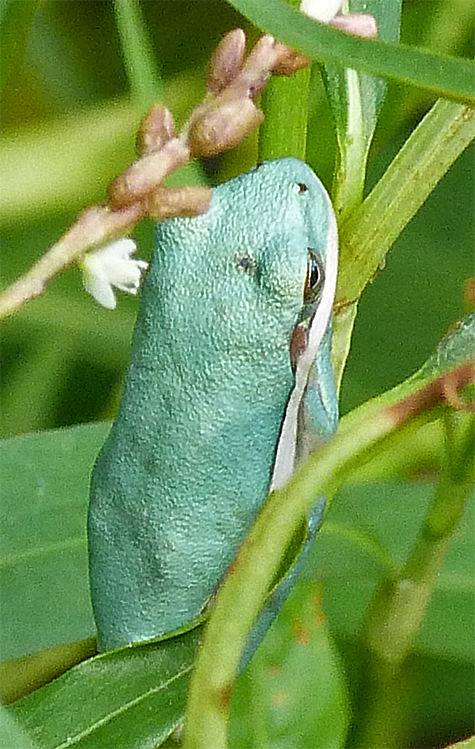As a naturalist, I keep a watchful eye to the sky, ground, and all around as I make my way through Explore the Wild, Catch the Wind, and the Dinosaur Trail during my daily routine here at the Museum. That said, there are certain locations I can’t pass without stopping and making a thorough scan.
One of those locations is the patch of smartweed at the end of the boardwalk in Explore the Wild. Typically, there are pollinators visiting the flowers on the smartweed, perhaps a smartweed caterpillar munching on the leaves, a meadow katydid or two, snakes and bullfrogs trying to either find or avoid one another and, well, you never know what you may find by leaning over the rail at this point on our 700′ boardwalk, no matter what time of year it is.
It was on one such typical day in October (10/8) that I happened to be standing at the end of the boardwalk staring down at the smartweed looking for green tree frogs. I’d been seeing one in this very location almost daily for the past couple of months perched on either a leaf or stem of one of the plants. They blend in well on the smartweed, having green skin, even so far as having a light stripe down their sides to match the center vein of the smartweed leaf.
I found a tree frog. But, it was blue, not green.

At first glance, I wasn’t sure it was a green tree frog. There’s always the possibility of an introduced species or an escapee from someone’s collection finding their way into the local fauna. However, other than a few poison dart frogs of Central and South America I knew there weren’t any, or many, blue colored frogs anywhere in the world. Being the object of many a predator’s attentions, frogs need to match their surrounds. I was certain there weren’t any wild “blue” tree frogs in our area, the North Carolina Piedmont.
The frog had the characteristic light stripe on its side. It was the right size and shape. What else could it be? It had to be a green tree frog (Hyla cinerea).

Having established the species, I wondered why this frog was blue and not green (or teal, as some have suggested). I’ve seen green tree frogs that were nearly yellow, leaf green, dark or forest green, olive-green and chocolate-brown. Those color variations are due to the individual’s temperature, the color of the object it happens to be perched upon at the time, or mood. Most frogs are darker when the ambient temps are low. Green tree frogs can and do change their color.





Maybe this frog is dead. Throughout my travels, I’ve seen several road-kill rough green snakes. They were all blue. A healthy live green snake is as green as any green tree frog. But, they turn blue when they die.
Below the snake’s (frog’s too) epidermis, the outer layer of skin, there are three layers of cells called chromatophores. The bottom layer consists of cells which produce melanin which appear black or brown. The middle layer contains cells which are crystalline, gray in color but which appear blue when reflected back through the skin (this reflective layer is responsible for the iridescence in snakes and frogs). The top layer produces yellow pigment. When the animal dies, yellow pigment is no longer produced, only the blue is reflected back (yellow and blue make green).
I’ve never found a dead frog sitting on a leaf, or clinging to a plant stem. They’re usually part of the pavement, upside down in the water, or in some other unpleasant or mangled position. This frog seemed at ease, resting on a smartweed leaf. Besides, by the time I made another trip around the loop through Explore the Wild, Catch the Wind and the Dinosaur Trail, and back pass the patch of smartweed, the frog had changed leaves. Dead frogs don’t move.
I discovered through research that our “blue” green tree frog apparently has a genetic abnormality in which yellow pigment is not produced. Take away the yellow and you have blue.
I searched the internet and found three or four cases of “blue” tree frogs whose skin is, in normal specimens, green. One, was a Pacific tree frog (Hyla regilla) discovered in Eureka, California, near Humboldt State University in northern California. Several others were from Florida, all of which were green tree frogs (Hyla cinerea), the same species found here at the Museum. At least two of the Florida frogs were splotched blue, patches of blue here and there on the frog. One all blue tree frog, which was found in Corkscrew Swamp Sanctuary in southwestern Florida, was captured and put on display at the sanctuary. The Eureka frog was also captured and displayed in a terrarium.
Our frog too, is on display. If you want to see it, you’ll have to hike out to Explore the Wild and search the smartweed along the edge of our Wetlands. It’s still there, a week later (10/15). You’d better hurry though, the temperatures are dropping and this frog will soon be under the soil and leaf litter for the winter.
Since stumbling upon this unusual tree frog, I’ve discovered other species, North American species, that also express this mutation. Green frogs, bullfrogs, even rough and smooth green snakes in which this genetic anomaly makes an appearance can be found across the land. Any green reptile or amphibian which is normally green in color would appear blue if lacking yellow pigment. It’s not common, though, by any measure. In one account that I read, it’s a one in a million occurrence.
I’m not sure how accurate the one-in-a-million number is but I’m quite sure our little tree frog is indeed a rarity. If the frog survives the winter and lives to breed the following spring, passing on the “blue” gene, perhaps we’ll see more blue hued tree frogs in our Wetlands.
I’ll leave you with several more images of the “blue” green tree frog.



The lack of yellow pigment is referred to as axanthic. The individual in the photos is an axanthic green tree frog.
a = not
Xanthos = yellow
ic = pertaining to or having characteristics of
Have a good one!
I just saw two tree frogs in my marigolds, They were right on top of the flower. It had rained last night and the flowers were still wet.
It is said I love frogs.
I have an American green tree frog in a vivarium at my home. He was almost always brown in color when I first got him, but recently has shown much more green. He is reaching the end of his expected lifespan, and just this morning he hopped out of his little cave and was bright green and pink! Truly beautiful, I wish I could have gotten a picture. In just the last few minutes, his brown coloration is beginning to come back. Any idea how or why his color changes so often? Could it be related to humidity?
It seems to me that green tree frog (all frogs) color is often related to the temperature, darker in cooler temps, lighter in warm weather. However, they may also change color in order to somewhat match whatever it is they’re clinging to, green stalks, they’re green, brown stalks or wood and the frogs may be brownish. And, humidity may very well play a part in their hue changes. I don’t recall seeing a pink one though.
Thank you for your response!! The pink is so beautiful, he has some around his webbing as well.
I understand this is an older Post, but I’m curious if an injury to the skin cells could affect the yellow pigment? I have a grey Tree frog who had a strange injury on her neck. It was “scarred” from one side of her face, around the back of her neck and stopped before the opposite eye. It healed nicely, but suddenly it’s coloured a very vibrant blue/turquoise when she goes “white” (she gets very pale on wooden surfaces), and turns to a more green/teal when she starts changing to darker colours. I’ve never seen this before and can’t find any other information relating to it!
I seems perfectly reasonable that an injury at the level of the pigment producing layer of skin would affect the colour of the frog at the site of the injury.
I live on the Mississippi Gulf Coast where I found a tree frog with the majority of his body turquoise blue hanging around my pool this week. Thank you so much for your blog about this because very little information seems to be out there when it comes to tree frogs with this abnormality.
I found a Aqua/Blue frog on our Front Porch light this morning! I have a couple of pictures.
Should I capture it and care for it, and maybe you could pick it up? Not sure what to do after reading your above Blog. My 1st instinct is that I have pictures, that should be good enough, and let the frog go on it’s way!
Yes, pictures are enough. Let the frog be. Consider yourself lucky to have seen the frog.
Thanks,
I just found this in my backyard just south of Fairhope, AL. Very cool! I feel blessed.
I just found a blue American Green Tree Frog outside my greenhouse in Goochland county Virginia…
Great! I keep looking, but haven’t seen another since the one in 2015, so count yourself lucky.
Thanks,
I found one of these the other day at our house in Okatie, SC. https://www.facebook.com/photo.php?fbid=2956550897742610&set=pb.100001631867635.-2207520000..&type=3&size=1072%2C1440
Hi so I have 2 green tree frogs and they both are a dark green color and all of a sudden today I noticed one of them is blue it just happened in a day and I don’t know what’s wrong he seems fine and still moves do u know why this happened or is it this mutation?
Are you sure it’s the same frog? I’m assuming these are wild tree frogs. I’d bet the blue one is different frog.
Regardless, as explained in the blog post https://naturewatch1.wpengine.com/blue-green-tree-frog/ the green tree frog looks blue due to the lack of yellow pigment in the top layer of its outer skin. There’s a melanin layer, a layer that reflects blue light, and a yellow layer on top. Yellow and blue make green (the amount of melanin either darkens or lightens the green). Take away the yellow and you end up with blue.
I live in Eureka, CA and yesterday (August 19, 2018) while at the College of The Redwoods Botanical Gardens, we saw many of these tiny blue frogs hopping from flower to flower in a patch of Black Eyed Susans. I just had to google them to find out what they were, as I’d never seen any before and they were really so unique and unusual and really pretty too. One actually hopped onto my finger! Thank you for this article and for identifying this frog. Otherwise, there was very little info to be found on them until I came across your article. Thank you so much!
Hi, I live in Simpsonville, SC. This summer, I have had numerous green tree frogs, usually 3 – 5 that gather around my back porch light every night. Late Monday afternoon I was pulling some weeds and a “blue” colored thing caught my attention nestled on a lily leaf. It was a blue tree frog! Thank you so much for this article.
Howdy– just looking this up since I just found a blue tree frog in my yard (it hopped away, so I only have a lousy phone pic). I’m right here on Birmingham Ave, across from the stadium; think we have a mutant population starting?
It could be a relative. Ellerbe Creek runs just a hundred feet or so from the bottom end of Birmingham Ave. And of course, Ellerbe Creek continues down stream, flowing through the Museum’s property. Interesting. Thanks,
awesome post Greg. And I’d say “teal”, too.
Amazing, nature never fails to provide new and wonderful sites. Thanks for providing all the research as to why this frog is blue.
Yes, every day there’s something new to discover!
Thanks,